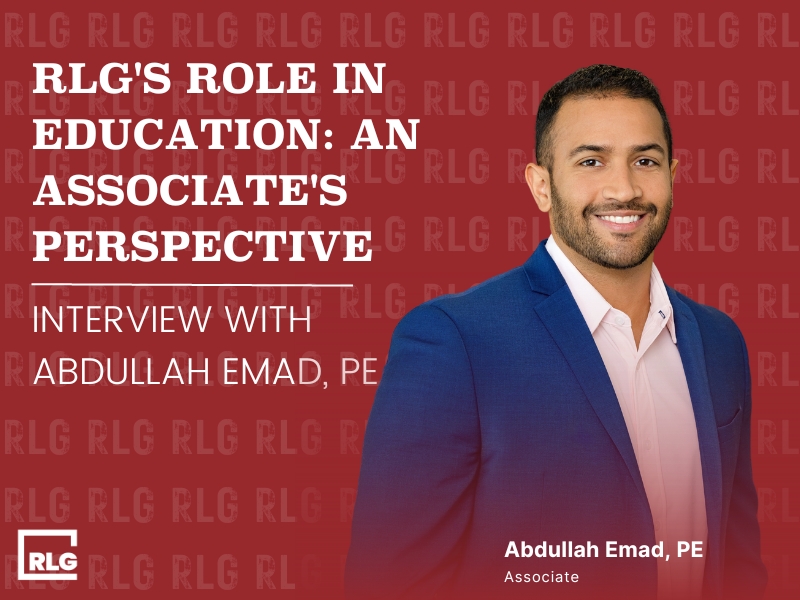
We interviewed Abdullah Emad, Associate, who has almost ten years of experience working on private and public education projects.
What is your role at RLG and how does it tie in with the K-12 Market sector?
I am an Associate at RLG. I’ve been working on education projects for public, private, and charter schools extensively since I started here in 2015. I also worked in the education sector with my previous employer, a general contractor. This has given me the experience of both designing and constructing school sites. I also have experience in designing roadways adjacent to education sites.
How has the K -12 education market sector grown in the last 5 years?
Lately, we’ve seen a push for Multipurpose Athletic Centers. These shaded structures or conditioned spaces are designed to get athletes out of the heat of Texas summers and early fall. Multipurpose spaces contain amenities like weightlifting rooms, practice fields, and offices for the coaching staff. We’ve also seen more storm shelters accompany any major educational improvement or development. Storm shelters are heavily reinforced structures that serve to protect students and staff in the event of a natural disaster. We are working on a gym addition at St. Mark's School of Texas that had its previous gym destroyed in a tornado. The new gym will have a storm shelter. This has more structural implications; however, we are involved in bringing a separate water service to the storm shelter to provide occupants with a source of drinking water in the event that the domestic water distribution system for the main structure is compromised. Lastly, there’s been a push for increased campus security through fencing, gates, and security guard shacks. There are typically crossings where these fences and gates lie on site with utility mains and easements. These crossings require encroachment agreements, which we’ve seen an uptick in since this push for additional campus security.
How does RLG approach the challenges and requirements that may be associated with designing educational facilities?
In the same manner that these institutions are designed for; an emphasis on collaboration. Education projects are a team effort. Our deliverables require input and design from other consultants, such as required queuing lengths from the traffic engineer, building utility stub outs from the plumbing engineer, tree locations from the landscape architect, etc. We approach all projects with collaboration in mind. Communication is the backbone of successful collaboration. We keep clients updated on city comments, how they impact the site design, and loop in other consultants for comments that require their input or modify their designs. Education projects introduce more partners for collaboration including, but not limited to, principals, staff, sanitation services, etc. Their input and campus operation drives successful site layouts and design.
What are some common challenges you have faced when designing educational buildings and how do you overcome them?
The most common challenge we face is balancing permitting timelines with architectural deliverables and construction schedules. We lean on the relationships we’ve formed with City staff and the familiarity we have with development timelines in different municipalities. We meet early and often with City staff to determine critical path design deliverables and immediately convey any concerns voiced by the City to our clients. This gives clients the opportunity to either revise their overall production schedule/timeline, or set up meetings with the City early on to tackle these issues collaboratively.
What is your favorite education project RLG has worked on thus far? Why?
My favorite education projects thus far have been the St. Marks Winn Science Center and Gymnasium additions. I attended Greenhill as a middle school and high school student. We were in the same conference as St. Marks. I am now a consultant for the same campus and fields that I used to walk through as a student-athlete. It’s rewarding to contribute to the development of students and athletes for current and future generations. It’s also a reminder of the inevitability of change, development, and progression of campus facilities. RLG’s involvement on the Greenhill gymnasium design is what interested me in applying to the firm. All education projects are rewarding and challenging. It’s especially rewarding when I am on a design team as an adult for a campus that I used to visit as a child.
How do educational buildings differ from other types of construction? What are some key differentiators?
One of the major driving factors for site layout and design is traffic queuing for parent pickup and drop-offs in the mornings and afternoons. This is a unique attribute specific to the operation of educational facilities. It’s critical to get input from a traffic engineer early in the design process. Traffic management plans help us determine how much queuing length is required for the school to operate within the site, specific to its programming. There are also large practice fields that drive the grading design for the overall site.
How does RLG stand out from other engineering firms in this sector?
We work in many different municipalities and institutions and have a firm understanding of design criteria and organizational processes. We can proactively work towards concurrent deliverables across team members and streamline the critical path for design and permit deliverables.

